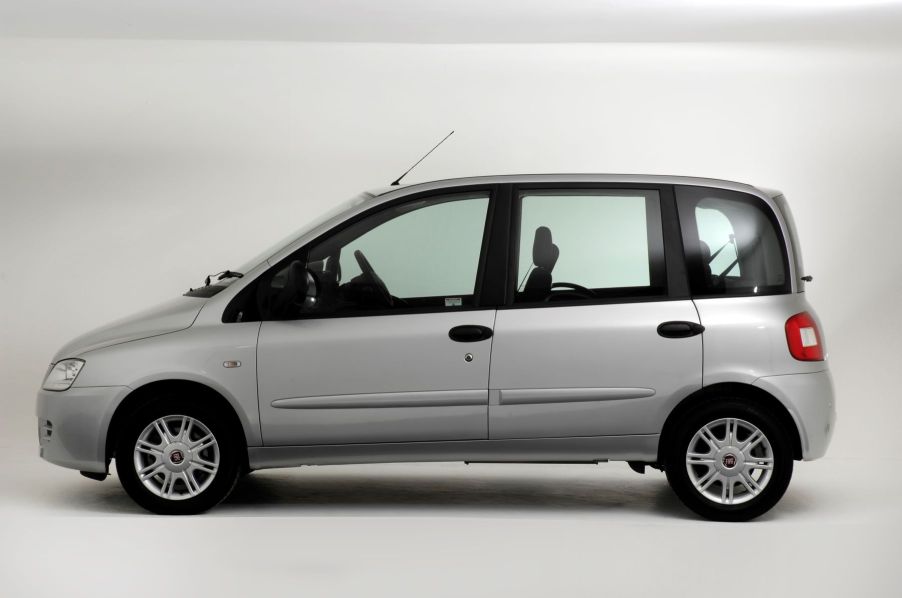
The World’s Ugliest Car Also Had Dangerously Lax Safety Standards
Safety is usually pretty high on the list if you’re looking for a family car. So, while you can forgive the Fiat Multipla for many things, including its toad-like looks, you might not be able to let its safety standards slide. That’s unfortunate because, while the Multipla may lack some things, it offers a lot of practicality and a rewarding driving experience in a small package.
Let’s take a closer look at the Multipla, including its background, safety record, and why it’s still a car people talk about.
A brief history of the Fiat Multipla
Based on the Fiat 600, Fiat first produced the Multipla in 1956 as a four-door MPV. With seating for six passengers, it somehow was measured at less than 12 feet long. Its vehicle architecture positioned the driver and front passenger over the front wheels with the engine situated in the back, reminiscent of the Volkswagen Microbus. By the end of its run, Fiat produced almost five million Multipla models.
In 1998, when Fiat decided to produce a new MPV, it revived the Multipla name. Based on the popular Fiat Brava, it reflected the spirit of the original 600 Multipla. Like its predecessor, it featured six-passenger seating in a three-across configuration instead of the original MPV’s three rows of two seats.
The Multipla was never sold in the U.S., partly due to safety standards

Why wasn’t the Fiat Multipla ever marketed and sold in the United States? One main reason is that the automaker abandoned the U.S. market in 1983, only returning nearly 30 years later in 2011, one year after the Multipla MPV model was retired. However, even if Fiat was still producing the Multipla, it likely wouldn’t have found its way to the U.S. due to not meeting safety standards.
We don’t have safety data on the Multipla for the U.S., but the Euro NCAP maintains data on it. Similar to the U.S. NHTSA or IIHS, the Euro NCAP is the European New Car Assessment Program.
According to the Euro NCAP, the Fiat Multipla has a three-star safety rating out of a possible five stars – an average rating. It’s not bad, but not great, either. Side impact scores are good, but the Multipla scores poorly in frontal impact safety. The rating agency summed up its report by saying, “The structural performance of the Multipla proved disappointing. There were hard structures under the facia that can damage occupants’ knees and upper thighs. The driver’s head struck the steering wheel and the facia mounting bracket began to pull away from the door pillar.”
That crash performance would earn the Multipla a “marginal” or “poor” rating in the U.S. By comparison, a Ford Focus from that same period, sold both in the U.S. and Europe, received a four-star rating. That rating translates to an “acceptable” rating by the IIHS.
The Fiat Multipla’s positives outweigh its negatives
Even with the poor crash scores and homely looks, the Fiat Multipla had a lot going for it, including the following:
- The Multipla offers excellent visibility with a driver’s seat that provides a commanding view of the road. It has minimal blind spots and offers the driver and passengers a panoramic view.
- It includes a visible driver’s display and easy control access. The layout is simplified with the gauge pod, and the controls are all neatly arranged and accessible.
- The shift knob is positioned close to the wheel and is positioned well for handling. Likewise, the clutch is progressive and easy to modulate. Both attributes make the Multipla an easy car to drive.
- Brakes are responsive, providing short stopping distances, no matter the type of surface.
- Despite its odd build, the Multipla handles surprisingly well with accurate and direct steering.
- Space, space, and more space. It’s surprisingly roomy with a lot of flexibility for interior configuration. It offers creative versatility that is almost unmatched.
Sure, there are bigger, safer, and roomier vehicles available. However, as a small MPV, it’s hard to match the Multipla’s versatility, fun-to-drive nature, and funky looks in a small package.




